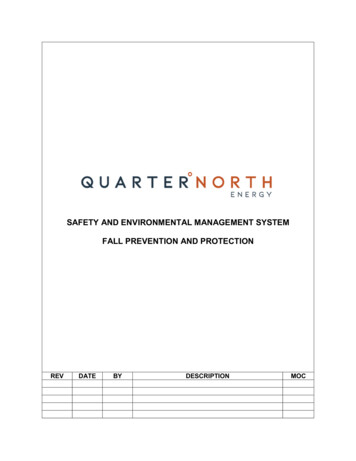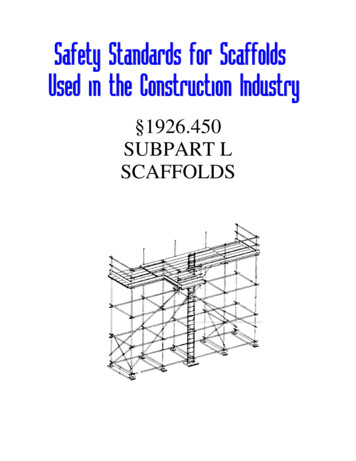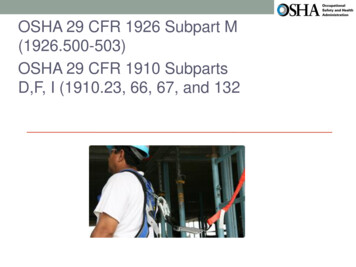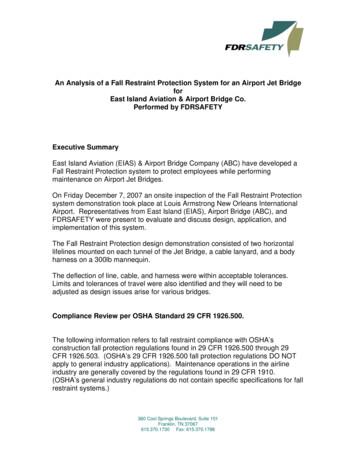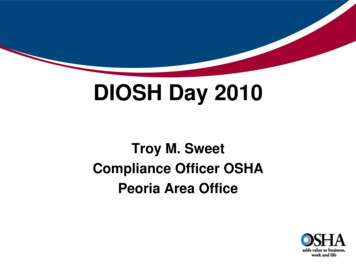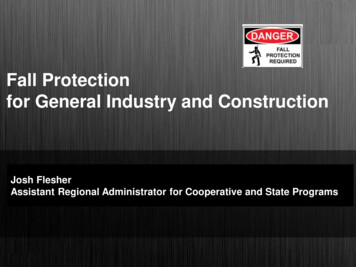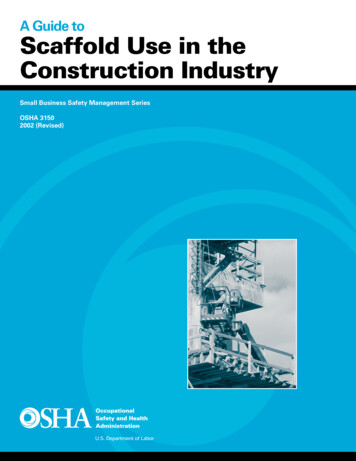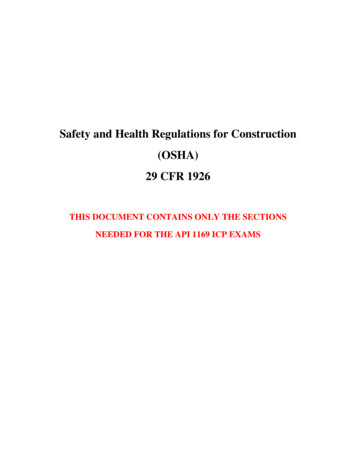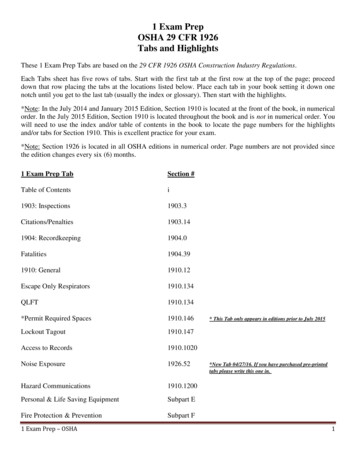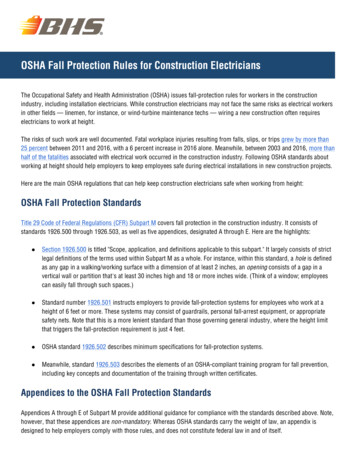
Transcription
WORKER HEALTH AND SAFETYA quick guide to 1926.62,Oregon OSHA’s constructionindustry rule for controllingexposure to lead.What you should know and not a word more!Oregon OSHA
A quick guide to 1926.62,Oregon OSHA’s construction industryrule for controlling exposure to lead.What you should know and not a word more!About this guideOregon OSHA’s quick guide to 1926.62 is an Oregon OSHA Standards and TechnicalResources publication. Oregon OSHA quick guides are for employers and employeeswho want to know about our requirements and get back to business quickly.Who should read this guide?Read this guide if you want to: Understand the key requirements of Oregon OSHA’s lead rule for the constructionindustry, 1926.62 Understand how to comply with 1926.62Note: This guide doesn’t cover the requirements for the Environmental ProtectionAgency’s Renovation, Repair, and Painting rule. This rule requires contractors whodo renovation, repair, or painting projects that disturb lead-based paint in homes,child care facilities, and schools built before 1978 to be certified and follow specificwork practices to prevent lead contamination. The rule is enforced by the OregonConstruction Contractors’ Board (CCB) and the Department of Human Services (DHS),Lead Poisoning Prevention Program.Piracy noticeReprinting, excerpting, or plagiarizing this publication is fine with us as long as it’s notfor profit! Please inform Oregon OSHA of your intention as a courtesy.
Table of ContentsWhat 1926.62 covers. . . . . . . . . . . . . . . . . . . . . . . . . . . . . . . . . . . . . . . . . . . . . . . . . . . . . . . . . 2Determining your employees’ exposure levels . . . . . . . . . . . . . . . . . . . . . . . . . . . . . . . . 3Trigger tasks and interim protection. . . . . . . . . . . . . . . . . . . . . . . . . . . . . . . . . . . . . . . . . . 5Air monitoring after your initial determination. . . . . . . . . . . . . . . . . . . . . . . . . . . . . . . . 6Observing exposure monitoring. . . . . . . . . . . . . . . . . . . . . . . . . . . . . . . . . . . . . . . . . . . . . . 7Using engineering and administrative controls. . . . . . . . . . . . . . . . . . . . . . . . . . . . . . . . 7Developing a written compliance program. . . . . . . . . . . . . . . . . . . . . . . . . . . . . . . . . . . . 8Providing respirators. . . . . . . . . . . . . . . . . . . . . . . . . . . . . . . . . . . . . . . . . . . . . . . . . . . . . . . . 9Providing protective clothing and equipment. . . . . . . . . . . . . . . . . . . . . . . . . . . . . . . . 10Keeping the site clean . . . . . . . . . . . . . . . . . . . . . . . . . . . . . . . . . . . . . . . . . . . . . . . . . . . . . . 11Ensuring proper hygiene. . . . . . . . . . . . . . . . . . . . . . . . . . . . . . . . . . . . . . . . . . . . . . . . . . . . 11Providing medical surveillance. . . . . . . . . . . . . . . . . . . . . . . . . . . . . . . . . . . . . . . . . . . . . . 12Providing medical removal protection. . . . . . . . . . . . . . . . . . . . . . . . . . . . . . . . . . . . . . . 14Training employees. . . . . . . . . . . . . . . . . . . . . . . . . . . . . . . . . . . . . . . . . . . . . . . . . . . . . . . . . 15Posting signs. . . . . . . . . . . . . . . . . . . . . . . . . . . . . . . . . . . . . . . . . . . . . . . . . . . . . . . . . . . . . . . 15Keeping records. . . . . . . . . . . . . . . . . . . . . . . . . . . . . . . . . . . . . . . . . . . . . . . . . . . . . . . . . . . . 16Important terms. . . . . . . . . . . . . . . . . . . . . . . . . . . . . . . . . . . . . . . . . . . . . . . . . . . . . . . . . . . . 181926.62: Key requirements summary . . . . . . . . . . . . . . . . . . . . . . . . . . . . . . . . . . . . . . . . 20Oregon OSHA Services. . . . . . . . . . . . . . . . . . . . . . . . . . . . . . . . . . . . . . . . . . . . . . . . . . . . . . 24
What 1926.62 coversThis rule covers construction work where your employees may beexposed to lead.Examples of activities covered by the rule: Disturbing paint on structures built before 1978 Doing demolition and salvage work Removing or encapsulating materials containing lead Renovating structures that contain lead Installing products that contain lead Emergency cleanup of lead-contaminated materials Transporting, storing, or disposing of lead-containing materials where constructionwork is performed Doing maintenance work involving these activitiesWho could be exposed?2 Carpenters Heating/air conditioning installers Contractors Maintenance workers Demolition workers Painters Drywallers Plumbers Electricians Wallpaperers Handymen Window replacement installers
Determining your employees’ exposure levelsIs lead present where your employees will be working?If so, you need to determine whether their work will expose them to lead. This is called aninitial determination.You can find out if your employees are exposed to lead by sampling the air they breathe withspecial equipment. This is called air monitoring (also, exposure monitoring).You can take an air sample representative of the work shift that you think has the highestexposures to lead.hand-point-rightThe amount of lead in the air is measured in micrograms per cubic meter(µg/m3). One microgram equals one millionth of a gram.hand-point-rightYou can do air monitoring yourself if you know how to do it and if you have theright equipment, which you can rent. You can also hire a consultant, or yourworkers’ compensation insurance carrier may be able to help.Know the action level and the permissible exposure limit Action level: This is the exposure level at which you must act to protect your employees.Thirty micrograms per cubic meter of air (30 µg/m3) averaged over an eight-hour period iscalled the action level. Permissible exposure limit: You must ensure that your employees aren’t exposed to leadat levels greater than the permissible exposure limit even if they are wearing a respirator.Fifty micrograms per cubic meter of air (50 µg/m3) averaged over an eight-hour period iscalled the permissible exposure limit or PEL.3
Using other information for your initial determination If you have sampled for airborne lead in the past 12 months, you can use that data for yourinitial determination if the testing conditions and tasks are similar. You can use the datafrom one or more projects as long as the tasks, conditions, and the percentage of leadinvolved are similar. You can use exposure-level data from industrywide studies or from manufacturers’ testsof products similar to those your employees are exposed to, if the data shows workers’exposures are below the action level. Exposure-level data is also called objective data.My employees are remodeling an older home.How do I know if lead is present?For buildings built before 1978, you need to presume that the paint contains lead, unless youhave information that all of the coatings, including the primer, did not contain lead or havebeen completely stripped off after 1978. You cannot use lead paint test kits, X-ray fluorescence(XRF), or laboratory testing alone to prove the absence of lead, as none of these methods canshow that there is no lead at all. A lead concentration of 0.0015 percent can still lead to airborneexposures at the action level.4
Trigger tasks and interim protectionTrigger tasksThe following tasks can expose workers to extreme amounts of lead. If your employees do anyof these tasks, you must assume they are exposed to lead at levels above the PEL until youhave done an initial determination. Cutting with a torch Heat gun work Manual sanding Manual scraping of dry materials Sanding with a dust collection system Spray painting Manual demolition of structures such as dry wall, windows, and siding Sanding without dust collection systems Abrasive blasting Lead burning Torch burning WeldingThese tasks are called trigger tasks because they trigger a set of interim measures you musttake to protect your employees.Interim protective measuresIf your employees do trigger tasks, you must provide them with all of the following until youcan show they are exposed below the action level: Appropriate respirators Protective clothing Clean areas for changing and storing clothing Handwashing facilities Blood sampling for lead Training that covers lead health hazards and all parts of 1926.625
Air monitoring after your initial determinationIf your employees are exposed to lead above the action level, you must do additionalmonitoring that is representative of the exposure of each employee.6If: Employees are exposed betweenthe action level and the PEL.Then: Monitor every six months until twoconsecutive measurements, taken at least sevendays apart, are below the action level.If: Employees are exposed above thePEL.Then: Monitor quarterly until exposures are belowthe action level.hand-point-rightNotify your employees of their monitoring results no later than five days afteryou receive the information.hand-point-rightIf any of your employees’ monitoring results are above the PEL, include thatinformation in the notification and tell them how you will lower their exposure.hand-point-rightIf your employees are not exposed above the action level, you don’t need todo additional monitoring unless a change in a work process or a job could raisethe exposure level.
Observing exposure monitoringYour employees have the right to observe any monitoring you do to assess theirexposures to lead.This includes: Receiving an explanation of the measurement procedures Observing all steps related to lead monitoring where the exposures are occurring Recording the monitoring results or receiving copies of the resultsUsing engineering and administrative controlsUse engineering and administrative controls to keep your employees’ exposures tolead at or below the PEL. If engineering and administrative controls don’t do this, youremployees must also use respirators.hand-point-rightEngineering controls change equipment, tools, or processes so employees’exposures to lead are eliminated or reduced. Using a sander attached to aHEPA vacuum to reduce dust is an example.hand-point-rightAdministrative controls change employees’ work practices and reduce theirexposures temporarily. Prohibiting workers from working in areas that exposethem to lead above the action level is an example of an administrative control.7
Developing a written compliance programYou must have a program in writing that describes how you will keep your employees’exposures at or below the PEL.Your program must: Describe each activity that exposes employees to lead Include any engineering plans and studies you used to determine your methods forcontrolling lead exposures Describe the technology you considered to keep exposures below the PEL Include air monitoring data that shows the source of lead emissions Include a detailed implementation schedule Include safe work practices for personal protective equipment, housekeeping, andhygiene facilities Include a job rotation schedule if you use administrative controls Describe your arrangements with other contractors so that affected employees know theymay be exposed to lead Include regular workplace inspections by a competent person8hand-point-rightA competent person is someone who can identify workplace hazards and whohas the authority to take prompt corrective action to eliminate them.hand-point-rightUpdate your compliance program annually.
Providing respiratorsProvide your employees with appropriate respirators when: They are doing any trigger task Their exposure to lead is greater than the PEL Engineering and administrative controls don’t reduce their exposures to or below the PEL An employee requests a respiratorhand-point-rightThe table shows examples of appropriate respirators for various exposure levels.Exposure levelAppropriate respiratorUp to 10 timesthe PELTight-fitting respirator with N-100, R-100, or P-100 filters,* depending onthe type of exposureUp to 50 timesthe PELSupplied-air respirator with helmet or hood; powered air-purifyingrespirator with helmet, hood, or loose-fitting face piece with N-100,R-100, or P-100 filters,* depending on the type of exposureMore than 50times the PELPowered air-purifying respirator with tight-fitting, full face-piece;supplied-air respirator with tight-fitting, full face-piece in continuousflow mode or other positive-pressure mode* N means not resistant to oil; R means resistant to oil; P means oil proof.You must also have a respirator program that meets theserequirements of 1910.134, v protection: 1910.134(b) Definitions 1910.134(c) Respiratory protection program 1910.134(d) Selection of respirators, except (d)(1)(iii) 1910.134(e) Medical evaluation 1910.134(f) Fit testing 1910.134(g) Use of respirators 1910.134(h) Maintenance and care of respirators 1910.134(j) Identification offilters, cartridges, and canisters 1910.134(k) Training andinformation 1910.134(l) Program evaluation 1910.134(m) Recordkeeping 1910.134(o) Appendices 1910.134(i) Breathing air quality and use9
Providing protective clothing and equipmentProvide your employees with protective work clothing and equipment that preventscontamination when: They are doing any trigger task before you’ve done an initial determination They are exposed to lead above the PEL They are exposed to lead compounds that may cause skin or eye irritationProtective work clothing includes: Coveralls or disposable full-body work clothes Gloves, hats, and shoes or disposable shoe coverlets Face shields and vented gogglesThings to do: Make sure your employees vacuum their shoes and work clothing with a HEPA vacuumbefore they remove them. Never use compressed air. Make sure your employees remove their protective clothing at the end of their shift inchange areas provided for that purpose. Make sure your employees place contaminated protective clothing in a closed, properlylabeled container in the change area. Provide clean and dry protective clothing to your employees at least weekly – and daily toany employees whose exposure levels are more than four times the PEL. Repair or replace their protective clothing to maintain its effectiveness. Label containers of contaminated clothing as follows:“Caution: Clothing contaminated with lead. Do not remove dust by blowing orshaking. Dispose of lead-contaminated wash water in accordance with applicablelocal, state, or federal regulations.” Inform in writing any person who cleans protective clothing about lead’s harmful effects.10
Keeping the site clean Use only vacuums that have HEPA filters for cleaning. Consider shoveling, wet sweeping, or brushing only when vacuuming is not effective. Don’t use compressed air to remove lead from surfaces unless you use a ventilation systemthat captures the airborne dust at the source.Ensuring proper hygieneFor employees who are exposed to lead above the PEL: Food, beverages, tobacco products, and cosmetics are not allowed in work areas. Clean change areas are required. Showers are required, when feasible. A clean eating area is required. Employees must wash their hands and face before eating, drinking, smoking, or applyingcosmetics.For employees who are exposed to lead, regardless of the exposure level: Change areas must have separate storage areas for protective work clothing and streetclothes. Employees cannot leave the workplace wearing the protective clothing they wore duringtheir work shift. If you cannot provide showers, make sure employees wash their hands and face at the endof their shifts. Encourage them to go home and shower immediately. Employees cannot enter lunchrooms or eating areas with protective work clothing unlesslead dust has been removed by vacuuming or another method that keeps the dust fromspreading. Handwashing facilities must include warm water and soap and meet the requirements of437-002-0141(5) Washing Facilities.11
Providing medical surveillanceAll your employees who may be exposed to lead at or above the action level must havebaseline blood sampling for lead and zinc protoporphyrin.hand-point-rightBlood sampling for lead and zinc protoporphyrin is called biological monitoring.The medical surveillance programYou must have a medical surveillance program for employees who may be exposed to leadat or above the action level for more than 30 days in any consecutive 12 months. A medicalsurveillance program includes biological monitoring and medical exams.Biological monitoring – what to doDo blood sampling for lead and zinc protoporphyrin for each employee covered by yourmedical surveillance program according to this schedule:12Employees coveredScheduleAll employees covered by the medical surveillanceprogramDo blood sampling at least everytwo months for the first six monthsand every six months thereafterEmployees whose last blood sampling andanalysis showed a blood lead level at or above 40micrograms per deciliter (40 µg/dl)Do blood sampling at least everytwo monthsEmployees who are removed from exposure to leaddue to elevated blood lead levelsDo blood sampling at least monthlyhand-point-rightNotify your employees no later than five working days after you receive theirblood sampling results.hand-point-rightNotify employees whose blood lead levels are greater than 40 µg/dl that theyare subject to temporary medical removal with medical removal protectionbenefits when their blood lead level is greater than 50 µg/dl. See “Providingmedical removal protection,” Page 14.
hand-point-rightIf the results of blood sampling indicate that an employee’s blood leadlevel is greater than 50 µg/dl, provide a follow-up blood-sampling test withintwo weeks.Medical exams – what to doProvide medical exams for each employee covered by your medical surveillance programaccording to this schedule:Employees coveredScheduleEmployees who have a blood sampling test during the past 12months with a blood lead level at or above 40 µg/dlAt least annuallyEmployees who report symptoms of lead intoxicationAs soon as possibleEmployees who are removed from exposure to lead because ofa final medical determinationAs medically appropriatehand-point-rightProvide the physician conducting a medical exam with the following information: A copy of 1926.62, including the appendices A description of the employee’s duties related to the exposure The employee’s exposure level (or anticipated exposure level) to lead and any othertoxic substance A description of any personal protective equipment the employee uses Any previous blood lead determinations Any previous written medical opinions about the employeehand-point-rightIf you choose a physician to conduct an employee’s medical exam, theemployee can choose another physician for a second opinion.hand-point-rightGive your employee a copy of the written medical opinion from eachexamining or consulting physician.13
Providing medical removal protectionRemove an employee from work who has an exposure to lead at or above the actionlevel when: A periodic and a follow-up blood-sampling test indicate that the employee’s blood leadlevel is at or above 50 µg/dl. A final medical determination finds that the employee has a medical condition that putsthe employee at increased risk from exposure to lead.hand-point-rightA final medical determination is the examining physician’s written opinion ofthe employees’ health status.You must provide an employee up to 18 months of medical removal protectionbenefits each time the employee is removed from exposure to lead.A “removed” employee can return to work when: Two consecutive blood-sampling tests indicate that the employee’s blood lead level is at orbelow 40 µg/dl. A subsequent final medical determination finds that the employee no longer has adetected medical condition.14
Training employeesTwo things you must do to train your employees:For all employeesInform all employees about lead hazards, following the requirements of 1926.59,Hazard communication.For employees who are exposed to lead at or above the action levelProvide training at least annually that covers the following: The content of 1926.62 and its appendices The nature of the work that could result in exposure to lead above the action level The purpose, selection, fitting, use, and limitations of respirators The purpose of the medical surveillance and the medical removal protection programs The engineering controls and work practices associated with employees’ jobs The content of any compliance plan in effect Instructions to employees that they should not use chelating agents except under thedirection of a licensed physician Employees’ right to access records under 1910.1020, Access to Employee Exposureand Medical RecordsPosting signsPost this sign in work areas where employees are exposed to lead above the PEL.DANGERLEADMAY DAMAGE FERTILITY OR THE UNBORN CHILDCAUSES DAMAGE TO THE CENTRAL NERVOUS SYSTEMDO NOT EAT, DRINK OR SMOKE IN THIS AREA15
Keeping recordsExposure monitoringKeep records of all monitoring data obtained from employee exposure assessments.Include: The date, number, duration, location, and results of each of the samples taken, if any A description of the sampling and analytical methods used and evidence of their accuracy The type of respirators worn, if any The names and job classifications of the employees monitored and of all other employeeswhose exposure the measurement represents The environmental variables that could affect the measurement of employees’ exposureshand-point-rightKeep these records for at least 30 years, following the requirements of1910.1020, Access to Employee Exposure and Medical RecordsMedical surveillanceKeep a record for each employee subject to medical surveillance.Include: The employees’ names and descriptions of their duties A copy of the physician’s written opinions Results of any air monitoring done for employees and provided to the physician Any employee’s medical complaints about lead exposureKeep or ensure that the examining physician keeps the following medical records: A copy of the medical examination results, including medical and work history A description of the laboratory procedures and a copy of any standards or guidelines usedto interpret the test results A copy of the results of biological monitoringhand-point-right16Keep these records for the duration of employment plus 30 years, following therequirements of 1910.1020, Access to Employee Exposure and Medical Records
Medical removalsKeep records of employees removed from current exposure to lead.Include: The employees’ names The dates they were removed from exposure to lead and the dates they returned to theirformer jobs A brief explanation of how medical removals are accomplished A statement that indicates if the reason for removal was an elevated blood lead levelhand-point-rightKeep these records for least the duration of each employee’s employment.Objective data for exemption from initial monitoringhand-point-rightKeep records of objective data used to exempt employees from initialmonitoring for at least 30 years.Requests for recordsMake these records available, upon request, to employees, former employees, their designatedrepresentatives, and to Oregon OSHA.17
Important termsaction level30 micrograms per cubic meter of air (30 µg/m3) averaged over an eight-hour period.administrative controlschanging employees’ work practices to reduce their exposures temporarily. Rotatingemployees among jobs, changing their work schedules, and prohibiting them from doinghazardous tasks are examples.biological monitoringblood sampling for lead and zinc protoporphyrin.engineering controlschanging equipment, tools, or work processes to eliminate or reduce employees’ exposuresto lead.air monitoring (also, exposure monitoring)determining if employees are exposed to lead by testing air samples in their work areas.final medical determinationa written opinion on the employees’ health status by the examining physician or physicians.initial determinationair monitoring to find out if employees may be exposed to lead at or above the action level –30 µg/m3 averaged over an eight-hour period.18
Important terms (continued)medical removalrequirement to remove an employee from work whose blood lead level is at or above50 micrograms per deciliter.medical surveillance programbiological monitoring and medical exams.objective datadata that shows employees are not exposed to lead dust or fumes in concentrations at orabove the action level.permissible exposure limit50 micrograms per cubic meter of air (50 µg/m3) averaged over an eight-hour period.Also called PEL.respirator programprogram that meets the requirements of 1910.134, Respiratory protection.trigger taskhigh-exposure work tasks that require additional measures to protect employees. Additionalmeasures include respirators, protective clothing, change areas, handwashing facilities, bloodsampling, hazard communication, and safety training.written compliance programdescribes how employees’ exposures will be kept at or below the PEL.19
1926.62: Key requirements summaryRequirementair monitoring – initialdeterminationWhere leadis presentregardless ofexposurerequiredair monitoring – requiredrequiredrequiredair monitoring – triggertasksrequiredengineering andadministrative controlsrequiredhazard ne practicesrequiredrequiredrequiredkeeping the site clean –housekeepingrequiredrequiredrequiredlead warning signs20at oraboveactionlevelrequiredair monitoring – after initialdeterminationair monitoring – allowingemployees to observeAirborne leadrequiredBlood leadabove40µg/dlabove50µg/dl
1926.62: Key requirements summary (continued)Where leadis presentregardless ofexposureAirborne leadBlood leadat dlmedical surveillance –biological monitoringrequiredrequiredrequiredrequiredmedical surveillance –examsrequiredrequiredrequiredmedical surveillance –temporary removalrequiredrequiredRequirementprotective clothing andequipmentrequiredrecordkeeping – exposuremonitoringrequiredrequiredrecordkeeping – medicalremovalsrequiredrecordkeeping – medicalsurveillancerequiredappropriate respiratorsrequiredrequiredtraining that covers leadhealth hazards and allparts of 1926.62written equiredrequired21
Notes22
Notes23
Oregon OSHA ServicesOregon OSHA offers a wide variety of safety and health services to employers and employees:Enforcement 503-378-3272; 800-922-2689; enforce.web@oregon.gov Offers pre-job conferences for mobile employers in industries such as logging andconstruction. Inspects places of employment for occupational safety and health hazards and investigatesworkplace complaints and accidents. Provides abatement assistance to employers who have received citations and providescompliance and technical assistance by phone.Consultative Services 503-378-3272; 800-922-2689; consult.web@oregon.gov Offers no-cost, on-site safety and health assistance to help Oregon employers recognizeand correct workplace safety and health problems. Provides consultations in the areas of safety, industrial hygiene, ergonomics, occupationalsafety and health programs, assistance to new businesses, the Safety and HealthAchievement Recognition Program (SHARP), and the Voluntary Protection Program (VPP).Standards and Technical Resources 503-378-3272; 800-922-2689; tech.web@oregon.gov Develops, interprets, and gives technical advice on Oregon OSHA’s safety and health rules. Publishes safe-practices guides, pamphlets, and other materials for employers andemployees. Manages the Oregon OSHA Resource Center, which offers safety videos, books, periodicals,and research assistance for employers and employees.Appeals 503-947-7426; 800-922-2689; admin.web@oregon.gov Provides the opportunity for employers to hold informal meetings with Oregon OSHA onconcerns about workplace safety and health. Discusses Oregon OSHA’s requirements and clarifies workplace safety or health violations. Discusses abatement dates and negotiates settlement agreements to resolve disputedcitations.24
Oregon OSHA ServicesConferences 503-378-3272; 888-292-5247, Option 1; oregon.conferences@oregon.gov Co-hosts conferences throughout Oregon that enable employees and employers to learnand share ideas with local and nationally recognized safety and health professionals.Public Education 503-947-7443; 888-292-5247, Option 2; ed.web@oregon.gov Provides workshops and materials covering management of basic safety and healthprograms, safety committees, accident investigation, technical topics, and job safety analysis.Need more information? Call your nearest Oregon OSHA office.Salem Central Office350 Winter St. NESalem, OR 97301-3882Phone: 503-378-3272Toll-free: 800-922-2689Fax: 503-947-7461en Español: 800-843-8086Website: osha.oregon.govBendRed Oaks Square1230 NE Third St., Suite A-115Bend, OR 97701-4374541-388-6066Consultation: 541-388-6068Eugene1500 Valley River Drive, Suite 150Eugene, OR 97401-4643541-686-7562Consultation: 541-686-7913Medford1840 Barnett Road, Suite DMedford, OR 97504-8293541-776-6030Consultation: 541-776-6016Pendleton200 SE Hailey Ave.Pendleton, OR 97801-3072541-276-9175Consultation: 541-276-2353PortlandDurham Plaza16760 SW Upper Boones Ferry Road, Suite 200Tigard, OR 97224-7696503-229-5910Consultation: 503-229-6193Salem1340 Tandem Ave. NE, Suite 160Salem, OR 97301-8080503-378-3274Consultation: 503-373-781925
Salem Central Office350 Winter St. NESalem, OR 97301-3882Phone: 503-378-3272Toll-free: 800-922-2689Fax: 503-947-7461en Español: 800-843-808626440-4907 (8/20/COM)Website: osha.oregon.gov
Resources publication. Oregon OSHA quick guides are for employers and employees . who want to know about our requirements and get back to business quickly. Who should read this guide? Read this guide if you want to: Understand the key requirements of Oregon OSHA's lead rule for the construction industry, 1926.62
